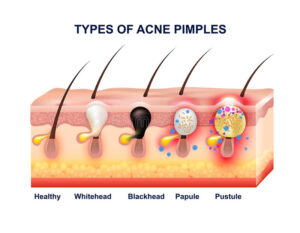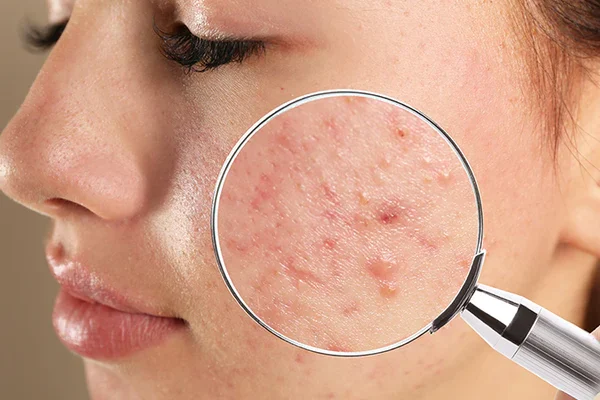What is a pimple?
Acne is a common skin condition that affects millions of people across the world. It also affects people across all different age groups. It occurs when hair follicles become clogged with oil and dead skin cells, resulting in the formation of pimples, blackheads, and whiteheads.
How is a pimple formed?
A pimple is a type of acne lesion that occurs when the hair follicles on the skin become clogged with oil, dead skin cells, and bacteria. This clogged pore forms a small, raised bump on the skin that can be red, inflamed, and sometimes painful.
The oil glands, also known as sebaceous glands, are located just below the skin’s surface and are responsible for producing sebum or oil on the skin. When the oil glands produce too much sebum, or when dead skin cells accumulate and mix with the sebum, it can clog the pores, creating the perfect environment for bacteria to grow.
When the bacteria enters this clogged pore, the area starts to get inflamed. This is what causes the swelling, redness and sometimes pain. All the above factors lead to the formation of a pimple.

Types of acne pimples
Let’s take a look at the several types of acne lesions:
- Whiteheads: Whiteheads are small, round, white bumps that form when hair follicles become clogged with oil and dead skin cells. They are typically found on the face, neck, chest, and back. Whiteheads are also known as closed comedones.
- Blackheads: Blackheads are similar to whiteheads, but they are open to the surface of the skin and appear black due to oxidation. When left for too long, these lesions can become very deep and very difficult to extract. These types of lesions can be found all over the face, nose and in some cases the ears as well. They are also known as open comedones.
- Papules: Papules are small, red, raised bumps that do not contain pus. They are caused by inflammation of the hair follicles.
- Pustules: Pustules are similar to papules, but they contain pus. They are typically larger and more inflamed than papules.
- Nodules: Nodules are large, painful, solid bumps that form deep within the skin. They are caused by a buildup of oil and dead skin cells within the hair follicle. Nodules are usually difficult to treat and sometimes require over-the-counter medications and typically require prescription medications such as oral antibiotics or isotretinoin. In some cases, they may need to be drained by a dermatologist.
- Cysts: Cysts are similar to nodules, but they are filled with pus. They are typically large and painful and can cause scarring. Cysts are difficult to treat with over-the-counter medications and typically require prescription medications such as oral antibiotics or isotretinoin. In some cases, they may need to be drained by a dermatologist.
Now that we had an in depth look at what a pimple is and how all the different types of pimples look, people often wonder why they are more predisposed to get pimples than someone else.
There are several factors that can contribute to a person’s predisposition to developing pimples or acne. Here are some of the most common factors:
- Hormones: Hormonal changes, particularly during puberty, can cause an increase in oil production in the skin. Drastic hormonal changes can also happen during pregnancy that lead to the formation of acne in adults. Others might also experience that they get more pimples during or close to the time of their menstrual cycle.
- Genetics: Some people may have a genetic predisposition to developing acne. If one or both parents have a history of acne, their children may be more likely to develop it as well.
- Diet: Certain foods, particularly those high in sugar and refined carbohydrates, may contribute to the development of acne in some individuals. Dairy products may also be a trigger for some people.
- Stress: Stress can trigger the release of hormones that contribute to acne development. In addition, some people may pick at their skin or touch their face more frequently when under stress, which can worsen acne.
- Medications: Certain medications, such as steroids and lithium, may contribute to the development of acne in some individuals.
- Skin care products: Some skin care products, particularly those that are oily or greasy, may contribute to the development of acne in some individuals.
- Hygiene: It is important to wash the face at least twice a day with clean hands or sponges. Often touching the face or picking on lesions with dirty hands will lead to more inflamed acne lesions. When the skin is left with a buildup of oil, bacteria and pollution the chances are higher for the bacteria to enter the hair follicle and to cause a pimple.
In conclusion, acne is a common skin condition that can be caused by different factors and it is important to get an understanding of what the reason may be. Pimples are also treated with a variety of medications and professional treatments. It is important to identify the type of acne lesions present to determine the appropriate treatment options. It is best to consult with a skincare therapist or in some cases a Dermatologist to get advise on the best approach to your specific
Click here to have a look at some of the best products to treat pimples and acne lesions.
